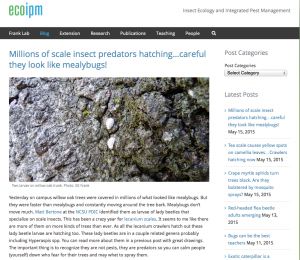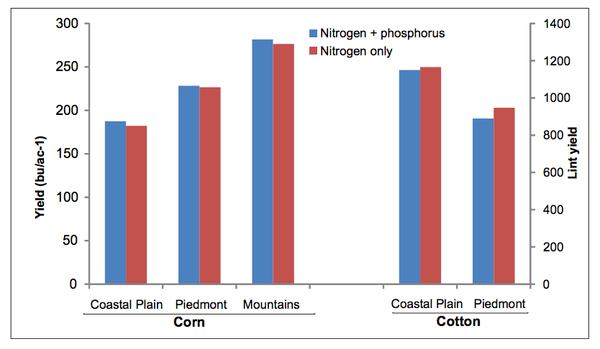Ambrosia Beetles Slow Down
This week did not find many ambrosia beetles in our traps this week (there will always be a few) …



Carteret County Center will be closed tomorrow, Fri 07/04/2025 for the holiday. We're closed Fri 7/4 and back on Mon 7/7. We look forward to hearing your Carteret County concerns. Have a happy & safe 4th!

Extension and research at NC State address timely issues impacting our state. Extension delivers trusted information directly into the hands of farmers and agribusinesses, helping them translate knowledge into solutions that grow our economy and communities.
El inglés es el idioma de control de esta página. En la medida en que haya algún conflicto entre la traducción al inglés y la traducción, el inglés prevalece.
Al hacer clic en el enlace de traducción se activa un servicio de traducción gratuito para convertir la página al español. Al igual que con cualquier traducción por Internet, la conversión no es sensible al contexto y puede que no traduzca el texto en su significado original. NC State Extension no garantiza la exactitud del texto traducido. Por favor, tenga en cuenta que algunas aplicaciones y/o servicios pueden no funcionar como se espera cuando se traducen.
Inglês é o idioma de controle desta página. Na medida que haja algum conflito entre o texto original em Inglês e a tradução, o Inglês prevalece.
Ao clicar no link de tradução, um serviço gratuito de tradução será ativado para converter a página para o Português. Como em qualquer tradução pela internet, a conversão não é sensivel ao contexto e pode não ocorrer a tradução para o significado orginal. O serviço de Extensão da Carolina do Norte (NC State Extension) não garante a exatidão do texto traduzido. Por favor, observe que algumas funções ou serviços podem não funcionar como esperado após a tradução.
English is the controlling language of this page. To the extent there is any conflict between the English text and the translation, English controls.
Clicking on the translation link activates a free translation service to convert the page to Spanish. As with any Internet translation, the conversion is not context-sensitive and may not translate the text to its original meaning. NC State Extension does not guarantee the accuracy of the translated text. Please note that some applications and/or services may not function as expected when translated.
Collapse ▲This week did not find many ambrosia beetles in our traps this week (there will always be a few) …
If you have conifers or other plants that seem to have grown weird, dangling pinecones, look again because you …
The Daylily leafminer is a recent pest from Asia. It was first detected in 2006 but has now spread …

If you like NC Pest News you might like the ecoipm blog. I use the blog to post information …
Spittlebugs are a group of insects in the Family Cercopidae (Froghoppers & Spittlebugs) that have the unusual ability to …
Organic tobacco acreage has increased throughout the southeast for 2015, and along with this increase has come more questions …
A recent post from Barclay Poling at the NC State Strawberry Growers Information Portal highlighted several grower questions about …
This link (Soybean 2015) provides a recorded presentation intended for agent training or broadcast in grower meetings. Please report …
O.A. Cleveland discusses why cotton prices have …
Some good cotton defoliation advice from Curtis D. Fountain, Duplin County Agricultural Extension Agent – Field Crops Overview Much of the …

We are between flights right now (access the trap data and select “corn earworm” on the right), having …

I’ve been getting a lot of questions on soybean insect thresholds. These were covered in a blog article three …

Several questions on have come in the during the past week about aphids on tobacco. In most cases, these …
Look no further! NC State Extension IT folks have created a real-time website that just came online in July. …

During the last two weeks, there have been several reports of mealybugs in wine grape vineyards. Mealybugs are sucking …

Stink bugs are tearing through cotton that has bolls. Both plant bugs and especially stink bugs and their damage …
Plant bugs are still being found and treated, even farther into the Coastal Plain than usual. It seems like …
Twospotted spider mites are the most common and significant pest of strawberries grown in North Carolina. Mite management strategies …
The US-EPA has renewed emergency exemption uses (Section 18) for the pyrethroid bifenthrin for control of the brown marmorated …

We exceed tobacco budworm thresholds at several of our scouting locations last week, which was also the case for a …

This publication discusses Anthracnose Fruit Rot (Colletotrichum sp.) of blueberries in detail. Included are the …

This factsheet for farmers describes concepts, terminology, and guidelines concerning soil sampling. Proper testing allows …

Phosphorus (P) is the second most important nutrient in crop production but is often found …
This factsheet summarizes the symptoms and management of stubby-root nematodes in soybean in North Carolina.
Lance nematode is not a common problem of soybeans, but can cause local damages in …
The reniform nematode is not a common nematode pressure for soybean growers in North Carolina, …

This soybean disease factsheet covers aerial web blight, a generally minor disease of soybean in …
This factsheet discusses bacterial blight of soybean in North Carolina.